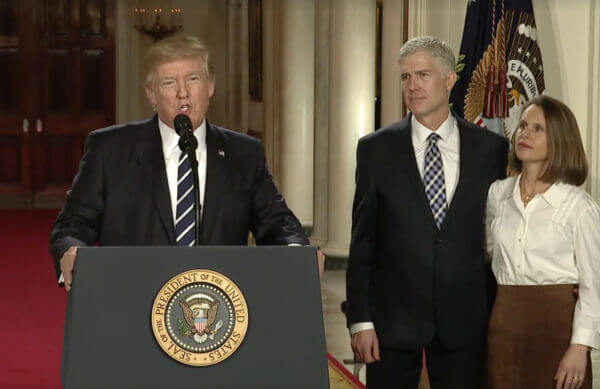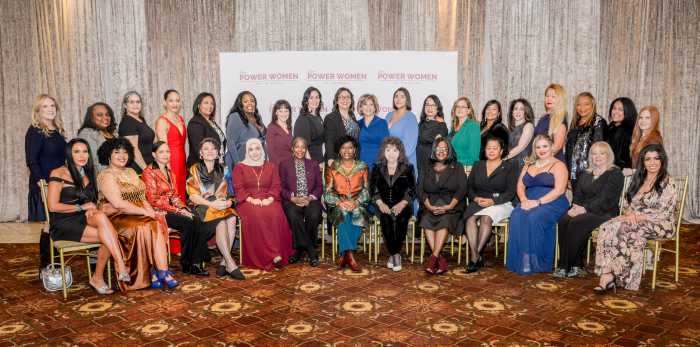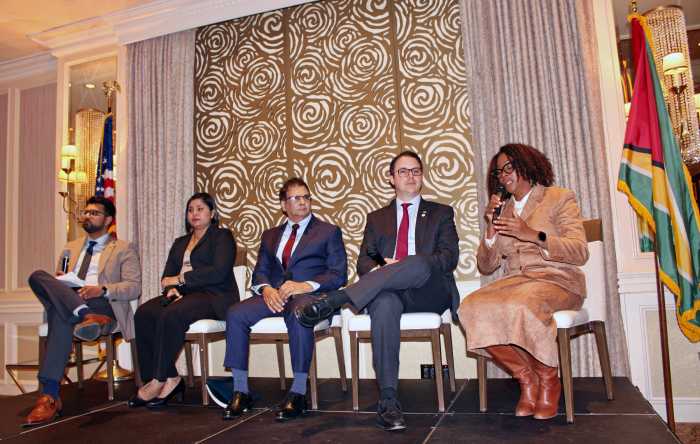The president-elect appears on a Times Square jumbotron in the early morning hours of November 9. | DANIEL KWAK
The Trump/ Pence ticket’s victory will have profound effects for LGBT law, and not just on the federal level. Some short-term effects should become apparent soon after the inauguration in January, while others may unfold for a generation or more.
Perhaps the most visible will be the impact on the Supreme Court, where the ninth seat has been vacant since Justice Antonin Scalia’s sudden death last winter. An eight-member Supreme Court can decide cases, but it takes at least five votes to make a ruling an official high court precedent. When the court ties 4-4 on a case, the lower court ruling that was appealed is “affirmed by an equally divided Court.” In that case, since there is no majority, no written opinion will be issued and no explanation given for why the justices voted as they did.
On the current court, one justice was appointed by Republican Ronald Reagan (Anthony Kennedy), one by Republican George H.W. Bush (Clarence Thomas), two by Democrat Bill Clinton (Ruth Bader Ginsberg and Stephen Breyer), two by Republican George W. Bush (John Roberts, the chief justice, and Samuel Alito), and two by Democrat Barack Obama (Sonia Sotomayor and Elena Kagan). When they divide along the political lines of the presidents who appointed them, there is no majority. They don’t always divide that way, however, and it is worth remembering that the four big gay rights victories of the past 20 years were opinions written by Kennedy.
Beyond his impact on the courts, Trump positioned to undo major Executive Branch pro-gay initiatives
When we lost Kennedy’s vote on the sharply divided Rehnquist Court in the case challenging the Boy Scouts’ anti-gay policy, we lost the case. (We lost some other cases during this period, but they were not by 5-4 votes — for example, the challenges to the Boston St. Patrick’s Day Parade gay exclusion policy and to the Solomon Amendment, which threatened loss of federal funds to colleges and law schools that barred military recruiters because of the Defense Department’s anti-gay policies.) As the senior judge on the court, Kennedy is a probable candidate to retire during the next four years, as is the oldest member of the court, Ginsberg.
Scalia’s death seemed to provide Obama with a brief window of opportunity to create a Democratic-appointed — and largely progressive — majority on the Supreme Court for the first time since the high-flying years of the court led by Chief Justice Earl Warren in the 1960s. Once Richard Nixon started appointing judges, the court moved to Republican conservative dominance. Jimmy Carter never got to appoint a Supreme Court justice, but Ronald Reagan and George H.W. Bush had several appointments each. Despite four terms of Democratic presidents since 1992, the balance has never swung back.
Obama’s opportunity was stymied by the Senate Republicans’ determination to deny him a third appointment to the court. With his first appointment, President-Elect Donald Trump will seal in the Republican conservative majority that was diminished by Scalia’s death, and his next appointment would likely move the court as far to the right as it ever has been in the past half century. It is unlikely that Trump would encounter serious opposition from Senate Republicans were he to appoint anybody on the lists he published during the campaign, all sitting judges with established conservative voting records in the mold of the justice he said is his favorite, Scalia.
On October 28, the high court agreed to review the Fourth Circuit’s decision from last spring holding that the district court in Virginia should defer to a US Department of Education’s interpretation requiring schools receiving federal funding to allow transgender students to use bathrooms consistent with their gender identity. The DOE heavily based that interpretation — of Title IX of the Education Amendments Act of 1972 — on the Equal Employment Opportunity Commission (EEOC) decisions on similar issues under the Civil Rights Act of 1964, which have applied prohibitions on sex discrimination to gender identity and sexual orientation claims .
The appeal will most likely be argued this winter, perhaps in February or March. If heard by an eight-member court, it may receive a tie vote affirming the Fourth Circuit, but creating no precedent nationwide. But if Trump’s first appointee is seated by then and participates, a decision on the merits may well reverse the Fourth Circuit, along the lines of a dissenting opinion written by one of the circuit panel judges in that case. Depending how it is written, such an opinion could affect not only student rights but also employee rights throughout the economy, by speaking affirmatively or negatively about the EEOC’s recent decisions.
PHOTO BY DONNA ACETO/ DESIGN BY MICHAEL SHIREY
New leadership at the Department of Education and Justice Department might even try to affect the issue raised in the Fourth Circuit case by rescinding the letter they jointly sent to school districts around the nation in May advising them about what Title IX requires concerning transgender students. Since it was not adopted as a formal regulation, it could be unilaterally rescinded. Although that would not render the pending case moot, because it was brought by a private party, it would affect several other pending lawsuits that specifically challenge the policies announced in that letter, effectively making them moot.
Those federal departments might also discontinue pending investigations. All over the country, school boards reacted to the Obama administration letter by debating policy changes, and many locals districts adopted polices in response. Those might end up being rescinded if the letter is withdrawn.
Even if the high court were to dispose of the Virginia “bathroom” case without setting a precedent, similar cases are in the pipeline and likely to come up to the court over the next few years. There are other lawsuits challenging the DOE’s s interpretation of Title IX, and there are appeals pending in several federal circuits considering whether the 1964 Civil Rights Act’s Title VII ban on sex discrimination in employment includes sexual orientation discrimination claims or gender identity discrimination claims. The court as altered by Trump appointments may be less receptive to such claims than a court completed through Hillary Clinton appointments.
The Supreme Court is only the most visible place for Trump to make an impact, however. Much of the progress on LGBT rights at the federal level during the Obama administration came from executive orders, formal directives issued unilaterally by the president to set internal policy for the Executive Branch. Obama expanded on executive orders left by Bill Clinton (and left untouched by George W. Bush) dealing with sexual orientation discrimination, extending them to gender identity discrimination and applying them for the first time to government contractors. The problem with executive orders is that a president is free to rescind or amend prior executive orders on the same unilateral basis as they are issued.
Over the summer, news reports indicated that the Trump transition team was readying a list of Obama administration executive orders for Trump to revoke as soon as he takes office. Many such orders and other informal presidential directives may be on the chopping block, including measures on immigration policy and labor policy, and, most likely, LGBT discrimination measures.
Executive branch agencies are also empowered to issue regulations and adopt guidelines for carrying out the requirements of federal statutes. A new administration can take steps to repeal or amend such policies, action which does not require approval by Congress. In the case of formal regulations, however, agencies must follow regulations specified by the Administrative Procedure Act, which can take several months or, sometimes, years, but an administration with a regulatory “to do” and “to repeal” list can probably decimate the Code of Federal Regulations within one term of determined effort.
Chai Feldblum, an out lesbian EEOC commissioner appointed by President Obama, has done much to advance the agency’s proactive posture on LGBT nondiscrimination policy. | US EQUAL EMPLOYMENT OPPORTUNITY COMMISSION
Presidents don’t appoint only Supreme Court justices. They appoint judges to the federal courts of appeals, which decide thousands of cases each year, and to the federal district (trial) courts, which decide hundreds of thousands of cases each year. (By contrast, the Supreme Court disposes of only about 60 cases each year.) These lower federal courts play an important role in constitutional and statutory interpretation, and also decide thousands of cases that involve state law disputes between parties from different states.
Obama’s lower court appointments have transformed several of the circuit courts of appeals, turning formerly conservative benches in a much more progressive direction, and adding more people of color, women, and openly lesbian and gay judges than any prior president. Many of his appointees issued crucial decisions on marriage equality during the period leading to the Obergefell ruling in June 2015, and are now writing key decisions on discrimination. Just days before the election, a district judge appointed by Obama issued a ruling in a case brought by the EEOC on behalf of a gay victim of employment discrimination.
However, because the Senate has drastically slowed the confirmation of Obama’s appointments since Republicans took control in 2010 — virtually grinding the process to a halt over the last few years — there are many vacancies on the federal bench, which could be quickly filled by Trump and an eager Republican Senate with conservative judges, many of whom may be less likely to issue similarly favorable rulings.
Presidents also appoint the cabinet, of course, and key sub-cabinet officers throughout the Executive Branch. These are the people who make policy decisions for their departments and agencies about the interpretation and enforcement of federal statutes. Without amending existing statutes or regulations, they can decide whether to “clamp down” or “ease up” on enforcement, resulting in virtual deregulation of activities a past administration worked to regulate.
For example, we have a Clean Air Act and a Clean Water Act, but it is up to the discretion of environmental regulators whether to go after violators. The Justice Department has a Civil Rights Division, which has been very active under the Obama administration after years of passivity during the George W. Bush years. Given the hostility of Trump and Republican legislators to regulation, a slowdown in regulatory enforcement is a likely consequence of this week’s election, even if they don’t move to repeal the major regulatory statutes. But Republican majorities in both houses of Congress and a compliant president may yield repeals as well, including the number one target of Congress, the Affordable Care Act or Obamacare, which Trump campaigned to repeal.
One area likely to see immediate change is immigration policy. Changing the law is not so easy, because the US is bound under international law by various treaties on top of our statutory law. However, Trump’s attitude toward treaties expressed during the campaign was to renegotiate or even ignore the ones he does not like, and his hostility to immigration and refugee law was a centerpiece of his candidacy. Because Congress could not agree on immigration reform, Obama issued executive orders and policy directives, some of which have been challenged and even stalled in the courts, to achieve reform goals. Much of this could be countermanded by Trump without having to go to Congress.
Vice President-Elect Mike Pence, surrounded by anti-gay clergy, signing Indiana’s anti-gay religious exemptions law last year.OFFICE OF THE GOVERNOR/ INDIANA
The State Department, meanwhile, plays a crucial role in documenting human rights conditions around the world through its “country reports” issued annually, which are then relied upon, especially by immigration judges deciding asylum and refugee cases. Under the Bush administration, the treatment of LGBT concerns was spotty and relatively unengaged. After Hillary Clinton became secretary of state, a new attitude permeated the department on LGBT issues, resulting in stronger reporting in the country reports and LGBT rights advocacy by ambassadors in foreign postings, as well as the addition of special ambassadors to address LGBT issues. These developments, which have been continued by Secretary John Kerry, may not survive a change of administration.
The president also appoints the directors, commissioners, and general legal counsels of the “independent” administrative agencies, such as the EEOC, the National Labor Relations Board (NLRB), and the Federal Reserve Board. These appointments are for statutorily-defined terms, usually staggered so a president has one appointment to each agency per year.
For example, the NLRB, which enforces statutes governing the relationship between workers, unions, and companies affecting interstate commerce, has five members. The NLRB decides appeals from decisions by administrative law judges, and its rulings can be appealed to the federal appeals courts. It also issues procedural regulations, and its regional directors, appointed by the Board, may seek injunctions from district courts to enforce board policies and oversees union representation elections and investigates charges of statutory violations. The president also appoints the Board’s chief legal officer, who oversees much of the agency’s investigative and enforcement activity. No more than three of the Board’s members can belong to the same political party. That means if the board is fully staffed, a new president may take a year or two to achieve a majority from his or her party. However, because of the Senate’s refusal to confirm Obama nominees, there are already two vacancies on the NLRB, and one more will open up in 2017. The Supreme Court has ruled that the NLRB can’t decide cases without a quorum of three confirmed Board members.
Trump could immediately alter the political complexion of the agency, which tends to swing between being pro-union or anti-union depending on the politics of appointing presidents, by filling the two vacancies and promptly filling the third later next year. This can have enormous significance for workplace rights. It is noteworthy that just days ago the NLRB found that a Trump hotel violated federal law in its refusal to negotiate with a union. (I began teaching Labor Relations Law at New York Law School in the fall of 1982, just as President Ronald Reagan’s appointments to the NLRB came into full power. They overruled so many Board precedents in a matter of months that I had to prepare a thick supplement to the textbook, which although relatively new was already seriously out of date.)
Perhaps the most consequential of these independent agencies for LGBT legal rights these days is the EEOC. An openly lesbian commissioner appointed and reappointed by Obama, Chai Feldblum, has taken the lead in persuading the agency to rule that sexual orientation and gender identity discrimination violate the Civil Rights Act’s ban on sex discrimination, and those rulings have begun to earn deference from federal courts as well as other agencies enforcing federal statutes. The EEOC’s interpretive rulings have been the main source of progress on anti-LGBT discrimination in private sector and state and local government employment during the Obama years, and it is unlikely that a Republican Congress would pass or Trump would sign the Equality Act, which would make such rules explicit. The loss of Feldblum’s voice when her current term ends on July 1, 2018 — as well as the appointment of less progressive commissioners to fill the seats that will open in subsequent years — will likely drastically affect enforcement priorities and interpretations at the EEOC, and have a ripple effect through the Civil Rights Offices in other Executive Branch agencies.
Some gay Republicans have argued that Trump was the most pro-gay candidate his party has ever nominated, and even suggested he was more pro-gay than Hillary Clinton, who only came around to endorsing marriage equality after Obama had “evolved” on the issue prior to the 2012 re-election campaign. Despite that specious claim, Trump has, in fact, voiced the GOP party line that these issues should be left to states and local governments to decide, that last year’s marriage equality decision should be reversed, and that federal law should emphasize the right of religious people to refuse to do business with gay people if it offends their beliefs.
Trump’s running mate, Vice President-Elect Mike Pence, was among the nation’s most anti-gay governors in Indiana, gleefully signing into law a “religious freedom” act that could be used by businesses to defend discrimination against gay customers and employees at a ceremony surrounded by anti-gay clergy, and fighting tooth and nail to prevent recognition of same-sex marriages and to amend the State Constitution to ban them. Since Trump is expected to delegate major responsibility for domestic policy to Pence, it seems unlikely at best that the federal government will be a force for gay rights in their administration the way it became during Barack Obama’s eight years in office.









































